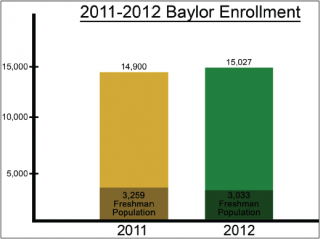
Matt Hellman | Lariat Photo Editor
By Daniel C. Houston
Staff Writer
Baylor’s freshman class earned the highest standardized test scores an incoming class at Baylor ever has and helped drive overall enrollment past the 15,000-student mark for the first time.
University enrollment now stands at 15,029 students up from 14,900 in the 2010 fall semester with 3,033 of those being first-time freshmen, according to a report published this week by the office of Institutional Research and Testing.
Baylor intentionally admitted 226 fewer freshman in this year’s class than last year’s, in part because of the difficulty associated with housing such large numbers of students in the past, said Dr. Jeff Doyle, dean for student learning and engagement.
Doyle went on to say on-campus housing facilities are at 98.3 percent capacity, meaning the university has not had an issue with overcrowding in the dorms this year.
The IRT report also indicated the percentage of last year’s freshman class that returned to Baylor for a second year was 3.5 percent higher than that of the class prior. The retention rate for last year’s freshman class was 85.4 percent; the year before it was 81.9 percent.
“I can’t believe that we went up 3.5 percent in retention rate,” Doyle said, “which for a school our size is just massive.”
Doyle and Dr. Sinda Vanderpool, assistant vice provost for enrollment management, attributed the increase in second-year retention to the academic background of the entering students, among other factors.
“We did a bunch of retention data analysis,” Vanderpool said. “We found that the single greatest predictive factor as far as whether a student is likely to return to Baylor the following fall semester is their fall GPA. The higher that student’s GPA was, the more likely they were to come back to Baylor the following fall; the lower the GPA, the less likely they were to come back the following fall.”
A Thursday press release announced the incoming class earned a 1236 average on the SAT and a 27 average on the ACT, both Baylor class records. This gave Vanderpool a reason to be optimistic next year’s retention rate could be strong once again, she said.
According to the IRT website, fall 2010 first-time freshmen earned a 1218 average SAT score, and 26.4 average ACT score.
In addition to Baylor admissions, Doyle gave credit to several on-campus departments whose work he believes played a key role in increasing that retention rate.
The Paul L. Foster Success Center, the Division of Student Life, Student Financial Services and Baylor faculty across the board all attributed to creating an environment in which students could adjust to a new college environment and thrive academically, Doyle said.
“That’s one of the reasons we offer University 1000 and programs similar to that— because if [freshmen] get behind, it can be a big mountain to overcome,” Doyle said.
Vanderpool said one of the reasons why the retention rate is so important is because one of Baylor’s top priorities is producing the highest number of four-year graduates within its means.
“What we really want when we recruit a student to Baylor is for them to be successful and graduate in four years,” Vanderpool said.





